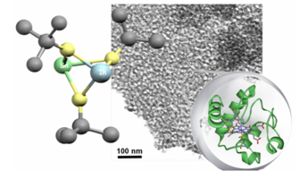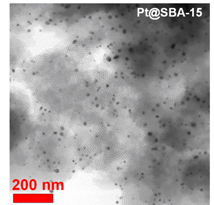A3 Synthesis of advanced catalytic materials
The performance of a catalyst, i.e. its activity, selectivity and stability, is largely determined by its preparation. In this respect, synthesis is certainly one of the key steps and the most influential unit operation for the development of a successful catalyst. Within this research field we aimed for the synthesis of advanced catalytic materials taking advantage of synthetic methodologies in molecular, polymer and inorganic materials chemistry.
Three main targets have been addressed in this research field:
Advanced materials and molecular models for activation of small molecules (CH4, O2,….)
Heterogenisation of homogeneous catalysts; functional/active supports
Synthesis of controllable interfaces of materials/biology for bioelectronics
This starts from synthesizing highly defined single-source precursors and preparing nanostructured materials with defined compositions therefrom, up to the large scale synthesis of materials, finally applicable in industrial plants.
Results/Achievements
Some prominent and recent examples of bi-directionality and synergism which have arouse from the Research Field A3 are shown in the following:
 |
Organometallic molecular single source precursors (SSPs) have been developed, which allow the synthesis of nanoscaled materials and catalysts with highly defined chemical composition, structure and functionality. Lithium-methylmagnesium alkoxide clusters have be shown to be particularly useful precursors for studying the stability of Li-MgO systems as potentially relevant catalysts for the OCM reaction (see Research Field A1) [1].
Another indium and tin-containing SSP has been transformed into the first tin-rich transparent conducting indium tin oxides (ITO) which could be furthermore successfully shaped into high surface area, mesoporous films and electrodes. Larger amounts of biocatalysts per electrode area can be immobilized on such materials to enhance the efficiency of bioelectrocatalytic processes [2;3].
Metal-organic catalysts have been immobilised in dendrimers to enable asymmetric transfer hydrogenations. High ee values (up to 99%) and good activities were achieved [4]. Also a novel heterogeneous asymmetric organocatalyst has been prepared by polymerization into open, highly porous network structure [5].
Tailor made supports have been developed for the immobilisation of molecular or nanoparticular catalysts. By introducing functional polymeric frameworks as supports, catalysts with highly dispersed nanoparticles have been prepared [6;7;8].
 |
Photocatalytically active mesoporous materials based on carbon nitride semiconductors have been synthesised and successfully utilised for the selective aerobic oxidation of alcohols [9] and also the oxidative coupling of amines driven by a photocatalytic cascade reaction [10]
One-pot, scalable protocols have been introduced for the generation of silica supported metal catalysts, which allow a controlled placement of the catalytically active species [11;12;13]
Most important publications
- S. Heitz, J.-D. Epping, Y. Aksu, M. Driess; Molecular Heterobimetallic Approach to Li-Containing MgO Nanoparticles with Variable Li-Concentrations Using Lithium-Methylmagnesium Alkoxide Clusters; Chem. Mater. 2010, 22, 4563-4571.
- Y. Aksu, S. Frasca, U. Wollenberger, M. Driess, A. Thomas; A Molecular Precursor Approach to Tuneable Porous Tin-Rich Indium Tin Oxide with Durable High Electrical Conductivity for Bioelectronic Devices; Chem. Mater. 2011, 23, 1798-1804.
- S. Frasca T. von Graberg, J. J. Feng, A. Thomas, B. M. Smarsly, I. M. Weidinger, F. W. Scheller, P. Hildebrandt, U. Wollenberger; Mesoporous Indium Tin Oxide as a Novel Platform for Bioelectronics; ChemCatChem 2010, 2, 839-845.
- J. Dimroth, J. Keilitz, U. Schedler, R. Schomäcker, R. Haag; Immobilization of a Modified Thethered Rhodium(III)-p-Toluenesulfonyl-1,2-dipehnylethylendiamine Catalyst on Soluble and Solid Polymeric Supports and Succesful Application to Asymmetric Transfer Hydrogenation of Ketones; Adv. Synth. Catal. 2010, 352, 32497-2506.
- C. Bleschke, J. Schmidt, S. Blechert, A. Thomas, submitted
- J. Zhu, K. Kailasam, A. Fischer, A. Thomas; Supported cobalt oxide nanoparticles as catalyst for aerobic oxidation of alcohols in liquid phase; ACS Catalysis 2011, 1, 342-347.
- C. E. Chan-Thaw, A. Villa, L. Prati, A. Thomas; Triazine-Based Polymers as Nanostructured Supports for the Liquid-Phase Oxidation of Alcohols; Chem. Eur. J. 2011, 17, 1052–1057.
- C.E. Chan-Thaw, A. Villa, P. Katekomol, D.S. Su, A. Thomas, L. Prati; Covalent Triazine Framework as Catalytic Support for Liquid Phase Reaction; Nano Lett. 2010, 10, 537-541
- F. Su, S.C. Mathew, G. Lipner, X. Fu, M. Antonietti, S. Blechert, X. Wang; mpg-C3N4-Catalyzed Selective Oxidation of Alcohols Using O2 and Visible Light, J. Amer. Chem. Soc. 2010, 132, 16299-16301.
- F. Su, S.C. Mathew, L. Möhlmann, M. Antonietti, X. Wang, S. Blechert; Aerobic Oxidative Coupling of Amines by Carbon Nitride Photocatalysis with Visible Light; Angew. Chem. Int. Ed. 2011, 50, 657-660
- J. Zhu, K. Kailasam, X. Xie, R. Schomäcker, A. Thomas; High Surface Area SBA-15 with Enhanced Mesopore Connectivity by Addition of Poly(vinylalcohol); Chem. Mater. 2011, 23, 2062–2067.
- J. Zhu, X. Xie, S. A. C. Carabineiro, P. B. Tavares, J. L. Figueiredo, R. Schomäcker, A. Thomas; Facile one-pot synthesis of Pt nanoparticles @SBA-15: A highly active and stable material for catalytic applications; Energy Environ. Sci. 2011, 4, 2020.
- S. Nowag, X. S. Wang, J. Keilitz, A. Thomas, R. Haag; Dendritic Core–Multishell Polymer Templates for the Synthesis of Pt Nanoparticle-Loaded Porous Silica and their Application as Catalysts for the Enantioselective Hydrogenation of Ethyl Pyruvate; ChemCatChem 2010, 2, 807 – 811.
Project team and expertise
| Prof. Dr. Markus Antonietti (MPI-KGF) | Mesostructured materials, sol gel chemistry, SAXS |
| Prof. Dr. Matthias Driess (TU Berlin) | Metalorganic chemistry; Precursor synthesis; Molecular models for heterogeneous catalysts |
| Dr. Anna Fischer (TU Berlin) | Porous conductive materials, surface functionalization |
| Dr. Ralph Krähnert (TU Berlin) | Gas phase catalysis, porous catalysts |
| Prof. Dr. Michael Lehmann (TU Berlin) | Optical near field spectroscopy, TEM spectroscopy |
| Prof. Dr. Christian Limberg (HU Berlin) | Oxygenation chemistry, metal oxo complexes |
| Prof. Dr. Helmut Schubert (TU Berlin) | Powder and materials technology, support and catalyst processing |
| Prof. Dr. Arne Thomas (TU Berlin) | Organic frameworks, functional materials |
Former team members | |
| Prof. Dr. Martin Lerch (TU Berlin) | Solid state chemistry |


